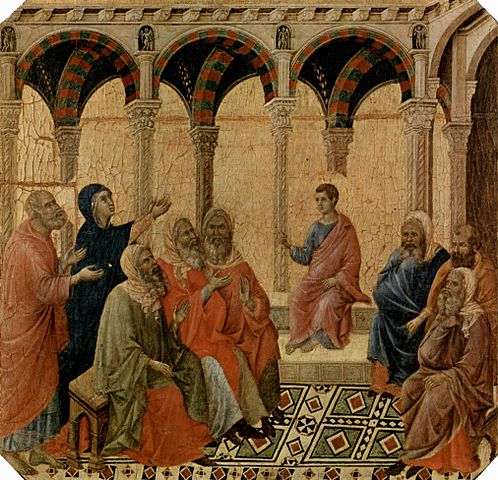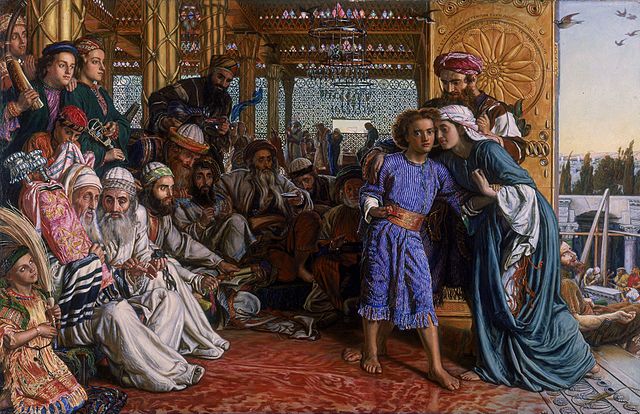On Friday I took the kids to our homeschooling group’s annual Lenten retreat. The theme of this year’s retreat was The Seven Sorrows of Mary. A young priest, Fr. Anthony Cusak, (himself a homeschool graduate) gave a meditation for the mothers that was just beautiful. As he spoke of the Flight into Egypt he referenced a painting at the MFA. I knew I needed to go look up the painting and also that I needed to go look up art to go with all the sorrows and to post them here with some of what I remember from his talk and some of my own thoughts and reflections. So here is the third of a planned series of seven posts. See the first here: The Prophecy of Simeon and the second: Flight into Egypt.

And when he was twelve years old, they went up as usual for the festival. When the festival was ended and they started to return, the boy Jesus stayed behind in Jerusalem, but his parents did not know it. Assuming that he was in the group of travelers, they went a day’s journey. Then they started to look for him among their relatives and friends. When they did not find him, they returned to Jerusalem to search for him. After three days they found him in the temple, sitting among the teachers, listening to them and asking them questions. And all who heard him were amazed at his understanding and his answers. When his parents saw him they were astonished; and his mother said to him, “Child, why have you treated us like this? Look, your father and I have been searching for you in great anxiety.” He said to them, “Why were you searching for me? Did you not know that I must be in my Father’s house?” But they did not understand what he said to them. Then he went down with them and came to Nazareth, and was obedient to them. His mother treasured all these things in her heart.
Luke 2: 42-51
Of course this is every parent’s nightmare: to lose your child. But for Mary it’s also a sign of what is to come, Jesus’ first revelation of who he is and what his mission will be. He leaves her temporarily now, only for three days, but there will come a day when he will leave again.
Three days. He was lost for three days. The prefigurement of the crucifixion couldn’t be more clear. And there’s something that gives me shivers. He was lost, but at the same time, he wasn’t wandering aimlessly, he was teaching in the Temple. He was in the Temple, which is a representation of heaven on earth.
The translation here (NRSV) is interesting: “His mother treasured all these things in her heart.” Treasured. She saves up her sorrows like treasures, hordes them in her heart like precious jewels. Who does that? Usually we want to push our sorrows away, hide them, forget the, overcome them. But Mary treasures them. These seven sorrows are her gift to us, to the poor banished children of Eve who cry to her for help. We cry to our mother who understands our pains and our griefs, who can journey with us and comfort us because she has suffered too. She consoles us with the same consolation she has received, the consolation of closeness to her beloved Son.
Mary knows how to draw close to Jesus even when he seems to have departed from her. She knows how to be close to him without clinging to him, without holding him back from his mission. She knows how to walk with him, to cherish even her own sufferings as pains which unite her with her Son’s suffering. In the Anima Christi we ask Christ to hide us in his wounds. Mary, surely, is already there, hidden away close to his wounded heart. And it is her very broken heart which allows her to remain near to him. The sword which pierces her heart is the same as the one that pierces his. That is the heart of Simeon’s prophecy. Every pain that Mary suffers is really one and the same, the pain of being the mother of the Savior, the pain of accompanying him to the cross. Her entire life is a journey to the cross, every step draws her closer to the cross and none more so that this moment when Christ has already begun to depart from her.
No painter captures this more clearly than James Tissot. His picture shows the child Jesus being led out from the Temple by Mary and Joseph, each of them holding onto one arm. But they hold him strangely, not holding him by the hands as parents usually do. Rather, they hold up his wrists so that he is positioned in a cruciform stance, palms facing up so that we can see the places where the nails will pierce him. Already, we see, he is preparing for crucifixion. And Mary and Joseph are helping him. It is a stunning moment. It also seems to echo the moment when Aaron and Hur prop up Moses’ hands as he stands on the hill overlooking the battle. Surely Jesus does not need Mary’s support as he goes to the cross, and yet he must have taken comfort from the fact that she was there, supporting him.
Mary is anxious and reproaches Jesus for causing her anxiety and yet she listens as he reproves her in turn and surely takes it to heart. Although she didn’t understand it at the time, I think that by the time of the crucifixion she does understand.
Tissot’s Life of Christ series has three paintings dedicated to this episode. The first shows Mary and Joseph at the end of the first day’s journey realizing that Jesus is not among the crowd of relatives. The second shows Jesus with the teachers in the Temple. The third shows Mary and Joseph leading Jesus out of the Temple, the teachers are in the background watching them depart. But most images show Jesus among the teachers with May and Joseph standing to one side.

In Duccio’s Disputation with the Doctors, Mary and Joseph stand behind the rank of the seated teachers, both of them reach out towards Jesus with pleading hands. But their faces are not turned to the seated child, who with raised hand is clearly instructing the elders, no, they are looking up to heaven, as if to ask God directly to explain what it is their child is doing. Jesus is seated in the highest position, the doctors ranged on either side of him as if he is the teacher and they are the students. He is stately, a prince on his throne, but he is turned slightly towards Mary and Joseph and it is possible his raised finger is a gesture that admonishes them. his face is calm, though. He knows what he is about. Mary’s face is not distressed, all her sorrow is expressed in her impassioned reach towards her son.

In William Hunt’s painting Mary has drawn Jesus a little off to the side, away from where he has been teaching a large gathering of more than a dozen scholars. She bends to whisper in his ear and he leans towards her as he listens intently. Her arm embraces his shoulder as she pulls him towards her while his hand holds her wrist–restraining her? Joseph stands behind the two of them, one hand raised on the strap of something he has slung over his shoulder, the other hand hovers over Mary’s hand where it rests on Jesus’ shoulder. They are united in their authority over Jesus. Also Joseph is protective of both his wife and child.
I love the rich colors and textures and the drama in this picture. Also, the detail of the beggar outside the door behind Mary who reminds us of Jesus’ future public ministry in the Temple, healing many lame and blind beggars.
Hunt’s Jesus emphasizes his childishness, I think, and the great contrast between him and the elders who he has been teaching. They have very distinctive dress and his short tunic is clearly childish compared to their robes. His hair is rather wild, an odd choice, and if he’s wearing a head covering, you can’t see it. He appears to be the only one with an uncovered head. Is that deliberate: everyone else covers their head out of reverence, but Jesus announces his divinity with his bare head?
Mary’s sorrow is not just the grief and anxiety at losing Jesus for three days, it is also in his words to her: “Why were you searching for me? Did you not know that I must be in my Father’s house?” She doesn’t understand and that, too, is a grief. His words cut to the heart for they insist on his separation from Mary and Jospeh, they remind her of his mission, which she still does not fully understand. This is the moment when she realizes he will leave her.


[…] a planned series of seven posts: First: The Prophecy of Simeon, second: Flight into Egypt, third: The Loss of the Child Jesus in the Temple, fourth: Meeting Jesus on the Way of the […]
[…] a planned series of seven posts: First: The Prophecy of Simeon, second: Flight into Egypt, third: The Loss of the Child Jesus in the Temple, fourth: Meeting Jesus on the Way of the Cross, fifth: The Crucifixion, sixth: The Descent from the […]